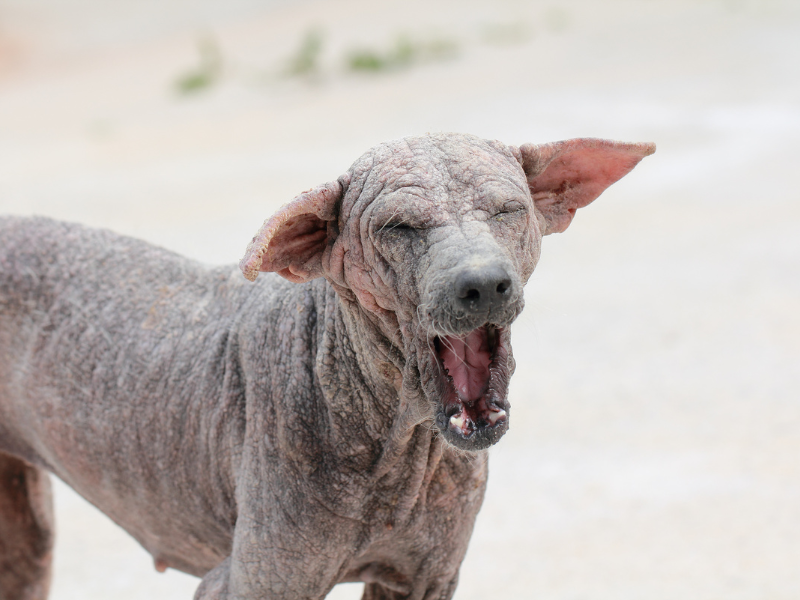You’ve most probably seen terrible pictures of animal rescue organizations rescuing mange-ridden mutts. However, you may not know that mange does not affect neglected dogs alone. This horrific but common skin disease in animals can strike any pet. When mange is left untreated, it results in soreness and hairlessness in a dog, and it gives your pet a lot of pain. Therefore, it is essential to treat mange as soon as you notice it in your pet. Do not allow your dog’s skin to turn to stone; treat your pet with natural remedies for mange.
Table of Contents
You will learn the following from this post:
What is Mange?
Mange is a skin disease called by a particular prolific parasite called a mange mite. Mites, however, are those tiny parasites that burrow below the surface of the skin and feed on skin cells. Mange in dogs is demodectic and sarcoptic, and different mites cause different kinds of mange.
Types of Mange

Demodectic and sarcoptic mages are similar, but they possess some apparent differences.
Demodectic Mange
Demodectic mange, also known as Demodex or demodicosis, results from a commonly occurring, cigar-shaped mite called Demodex Canis. This particular mite usually lives in every dog’s skin. Still, problems come when these mites become overpopulated because of the inability of the dog’s immune system to keep the mites under control.
Most dogs susceptible to demodectic mange have weak immune systems. Therefore, dogs that suffer from this type of mage either have their entire body become affected, or there are localized areas of the disease on their body. Fortunately, demodectic mange is not contagious.
Symptoms of Demodectic Mange
The following symptoms are common with demodectic mange:
- Crysty lesions
- Itchy skin
- Postal (small bumps that contain fluid or pus)
- Hair loss
Sarcoptic Mange
Sarcoptic made, usually called scabies, is a result of a parasite known as Sarcoptes scabiei. Sarcoptic mange often starts in one area of the body and can occupy the whole body if left untreated. Symptoms of sarcoptic mange usually appear anywhere on the dog’s body from two to six weeks of exposure. Therefore, dog parks, groomers, vet clinics, kennels, and shelters are prime places for dogs to get infected with sarcoptic mange.
Symptoms of Sarcoptic Mange
The following symptoms are common with scabies:
- Skin rash
- Hair loss
- Skin lesions may appear as bleeding scabs, oily discharge, or even thick crusts
- Intense, uncontrollable itching
Potential Complications of Mange
Mange that is not adequately treated can cause a few complications. Two of the noticeable complications are mentioned below:
1. Fungal and Bacterial Infections
The intense itching that mage causes will make most dogs scratch incessantly. This scratching can irritate your dog’s skin and allow fungal and bacterial infections to occur, which will complicate the treatment process. In a terrible case, your dog may require antifungal or antibiotic medications to combat these types of skin infections.
2. Zoonotic Potential
Although Demodex mites can be transmitted to human beings, they won’t cause you any severe health problems (if at all), and you will not even be aware that they are there. Of course, you most probably already have them on your body right now – haha, but it’s not something to worry yourself about.
However, when sarcoptic mange mite is transmitted to humans, it can cause some significant health problems. Sarcoptic mange mites cause the same issues in humans as in dogs, such as severe itching. When you notice the symptoms of sarcoptic mange on you, then consult your doctor immediately. Your health practitioner would prescribe the drugs that will help eliminate the bugs from your skin. The best way to avoid the bug getting to your skin is to treat your affected dog before the mites invade the family members.
Ineffective Conventional Treatment for Mange
Your vet may prescribe some topical or oral treatment for mange in your dog. In some cases, they may prescribe both. Here are some of the commonly prescribed OTC medications, but they are pretty ineffective. They can cause your pet more harm than good. It is better to consider natural remedies for mange.
1. Ivermectin
This drug is a heartworm medication. Most vets believe that Ivermectin is a safe medication, but it is not. The level of dosage of Ivermectin for mange treatment is significantly higher than for heartworm prevention. Therefore, it means that there will be a chance of high risk. Here is some other information you may want to know about Ivermectin:
It’s a Neurotoxin
The drug can be a threat to your dog’s nervous system. Ivermectin can result in a wide range of side effects, such as:
- Dilated pupils
- Dehydration
- Vomiting
- Breathing problems
- Loss of appetite
- Slow heartbeat
- Depression
- Lethargy
- Inability to stand
- Lack of coordination
- Blindness
- Seizures or trembling
MDR1 Gene Mutation
Ivermectin can be dangerous for some breeds. Dogs with MDR1 gene mutation should not take Ivermectin or any drug that belongs to the macrocyclic lactone class. When taken, Ivermectin may cause neurotoxic side effects in these breeds, such as tremors, seizures, or even death. Your vet may test your dog for this gene, but it’s most common in herding breeds like:
- Mixed breeds with the heritage of herding breed
- Silken Windhounds
- Long-haired whippets
- Skye terriers
- German shepherds
- Old English or English sheepdogs
- Shelties
- Collies
- Border collies
- Australian shepherds
2. Milbemycin Oxime
Milbemycin is another heartworm drug that is sold under the brand interceptor. However, using it for the treatment of dog mites is an “off-label” use. This means that the FDA has not approved it for this purpose. Like some other heartworm drugs, milbemycin oxime can affect your dog’s nervous system. Symptoms include the following:
- Excessive drooling
- Dilated pupils
- Weakness
- Lack of energy
- Depression
- Coma
- Seizures
- Collapse or stumbling
3. Selamectin
Selamectin is an effective treatment against parasites like ticks and fleas. It works like other drugs by paralyzing the parasites. A veterinary doctor may prescribe it for the elimination of sarcoptic mange.
8 Natural Remedies for Mange

Here are the top home remedies for dogs with mange. If your dog is suffering from any mange, consider using the following natural remedies for mange:
1. Borax and Hydrogen Peroxide
When used properly, a combination of borax and hydrogen peroxide works as one of the best and most effective natural remedies for mange. Hydrogen peroxide functions as a natural disinfectant and cleanser. It also helps in creating an environment unfit for the survival of mites. Borax is also a natural disinfectant, and it is pretty effective in killing fungi and insects.
Directions:
- Mix 2 cups containing 3 percent hydrogen peroxide in 4 cups of water.
- Add 3 tablespoons of borax to the solution.
- Stir until the borax dissolves.
- Thoroughly soak your pet’s skin with the solution.
- Allow the solution to settle on the skin for several hours. Do not bother to rinse the skin.
- Repeat the process daily for 2 or 3 days.
- Make use of this remedy once a week to reduce the risk of the infestation returning.
2. Apple Cider Vinegar
Unfiltered and raw apple cider vinegar is another natural remedy you can apply topically to control and treat mange infection in your dog. Apple cider vinegar is majorly effective because of its antimicrobial and antiseptic properties.
Directions:
- Mix a cup of apple cider vinegar with water. Pour the mixture into a spray bottle. Spray the mixture on your dog’s fur while combing in between at the same time. Ensure that the mixture completely saturates the skin. Leave the fur to air-dry. Apply this remedy 2 or 3 times each week, depending on how severe the mange is.
- An alternative way is by mixing a half cup of each apple cider vinegar with warm water and borax in a large bucket. Dip a clean, unused sponge in the solution and gently rub it all over your dog’s body. Leave the fur to air-dry. Apply this remedy 2 or 3 times each week.
- A third option is to add unfiltered, raw apple cider vinegar to your dog’s food at least once daily for a week. Please make sure the dose is 1 teaspoon for dogs weighing about 14 pounds, 2 teaspoons for a pet weighing between 25 and 34 pounds, and 1 teaspoon for dogs weighing between 35 and 85 pounds.
Do not apply undiluted apple cider vinegar to your dog’s body; the high acidity of it can cause a stinging sensation.
3. Sulfur Soap
The alkaline available in sulfur soap will eliminate mange and reduce inflammation. Also, the sulfur will kill the parasite responsible for the disease.
Directions:
- Soak your dog’s fur with water.
- Rub the soap around your skin until it becomes very foamy.
- Allow it to lather on the skin for half an hour to allow the mites enough time to move to the surface.
- Next, rinse your dog’s body with water until all the soap is no longer there.
- Allow your dog to shake itself before keeping him in the sun to air dry.
- Wash your dog with soap once or twice a week until all the signs of infection are gone.
4. Neem
Neem, also called Indian lilac, has many dermatological advantages for humans and animals, especially pets. The antiseptic nature of neem helps treat mange and eliminate the infection. Neem also soothes and nourishes the skin and fastens the regrowth of fur.
Directions:
- Buy an over-the-counter neem shampoo and use it to wash your dog every week.
- Boil a considerable amount of neem leaves in a pot of water for about 10 minutes. Leave the water to cool before straining it. Spray the water on your dog’s fur and leave it. Please do not bother to rinse it. Repeat the process at least once daily.
- You can also mix the same amount of coconut oil and neem oil. Apply the mixture to the affected area 2 or 3 times each day.
5. Vegetable Oil
Vegetable oil of any kind can also help eliminate mites and treat the mange. Due to the vegetable oil’s sticky nature, the air supply of the mites will be cut off, eventually killing them. Vegetable oil will also help soften the wax-like deposits left behind by the mites, which automatically saves the dog from constant scratching.
Directions:
- Soak a clean sponge in a container of vegetable oil.
- Rub your dog’s fur with the oil-soaked sponge.
- Ensure that you scrub all the dry and patchy areas.
- Follow this process twice daily.
6. Honey
Honey is a natural remedy that can effectively reduce your pet’s discomfort to an impressive extent. Honey is a powerful antioxidant that makes it difficult for mites to live on your dog’s skin for a long time. As a result, honey will provide your dog with relief from all the scratching and itching. Also, honey is a natural antiseptic that will help heal the skin and prevent any other infection in the future.
Direction:
- Apply honey that is harvested locally on the affected part of your dog’s skin.
- Leave it to stay on the skin for a few hours.
- Wipe away the excess with water to prevent ants from invading your dog’s body (honey attracts ants).
- Follow this process twice each day.
7. Lemon
Lemon is an effective remedy for various skin problems in humans; it is also great for animals. Because of its high level of acidity, lemon juice can successfully eliminate microscopic parasites. It is also quite effective in healing damaged skin.
Directions:
- Slice up one lemon (along with its peel) into small pieces.
- Add the pieces to a water-filled pan.
- Boil the mixture nicely.
- Kill the heat and cover the pan. Allow the solution to steep overnight.
- Apply the mixture to your pet’s coat the following morning with the use of a sponge.
- Do this once every day.
Avoid applying lemon directly on your dog’s open scabs, as it can result in a burning sensation.
8. Yogurt
Yogurt is very effective in treating the issue of crusting discharge from your dog’s ear as a result of mange. The acidophilus bacteria yogurt contains can help get rid of this symptom and relieve the discomfort your dog experiences. In addition, yogurt is soothing to the skin, and it helps clean the infected area of the skin.
Directions:
- Gently rub 2 tablespoons of plain, natural yogurt on the inside of your pet’s mange-infested ears.
- Wash it off with lukewarm water at the end of the day.
- Repeat this process daily until you notice no further discolored or crusty discharge from your dog’s ears.
Final Thoughts
Ensure that you regularly wash your dog’s bedding with hot water to eliminate mites that cause mange. If you treat your dog with mange and there are still mites in the dog’s bedding, there is a high possibility that the mange will return. Therefore, take your dog periodically to your vet to ensure that the mites and mange have been eliminated. If these natural remedies for mange do not work effectively for your dog, your pet’s condition may be severe. Consult your vet immediately for a proper diagnosis of the disease.
Post Disclaimer
The information contained in this post "8 Natural Remedies for Mange" is for educational purposes only. Always consult your primary care doctor before using the remedies that are provided. The information is provided by The Hidden Cures and while we do timely, in-depth research on the information that we provide to you, everything stated may not be up to date or accurate from the time it was written.

Could I try similar solutions to my 5 week old pigs? Thanks
Hi Ruth,
Yes, you could use these solutions on most pets because they are all natural. As always, consult with your vet prior to introducing new solutions to make sure they are safe.